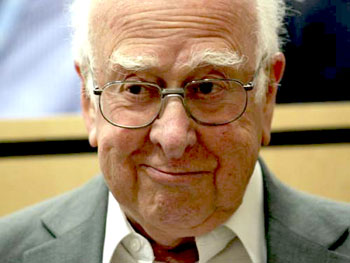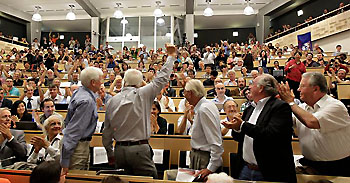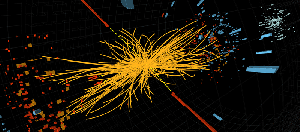The Higgs Boson? Maybe... By William Dowell, July 5, 2012 |
 Peter Ware Higgs was at CERN, Wednesday, to see his life work confirmed |
To understand the significance of the Higgs boson and, more important, the Higgs Field, you only need to watch a video of an atomic bomb blast. According to E=mc2, everything is energy. Only, the energy appears in different forms. It becomes mass--what we call matter--when it passes through the Higg's field.
The Higgs boson, whose existence was largely confirmed on Wednesday, July 4, , provides proof of the Higgs mechanism and Peter Higgs' amazing insight into the universe itself.
Peter Ware Higgs, now 83, was in the company of some of the world's leading particle physicists gathered at CERN (The European Center for Nuclear Research), while the verdict confirming the experimental findings was beamed around the world. Rolf-Dieter Heuer, the director general of CERN, announced "I think we have it." and then cautiously qualified his declaration by adding that a scientist couldn't be completely sure of just what it was that they had. The results were close enough, however, to make the call.
 Declaring victory at CERN |
The Higgs field is charged the way an electric field is, but it is not charged with electricity. Instead the Higgs charge has the effect of providing mass to the particles moving through it. The Higgs boson's importance stems from the fact that it is the most basic particle that demonstrates the Higgs mechanism. In a sense, it is the missing link between energy and matter. That insight is now almost certain to win Peter Higgs a Nobel prize and a knighthood. More important, it constitutes a critical mile popst in both physics and the humanity's understanding of the universe.
The particle only appears at extremely high energy levels, and until the creation of the Large Hadron Collider, it was impossible to reach those levels. It has been pointed out repeatedly in recent days, the nickname, "The God Particle," stemmed not so much from the fact that it is at the crux of the transformation of energy into matter, as it did from the fact that a physicist, writing about it, referred to it as that "goddamn" particle, a reference to its elusiveness. His publisher changed the name to "God particle," to avoid charges of blasphemy. In fact, the name fits philosophically.
The existence of the Higgs bosun is so short-lived that it is easier to deduce by detecting the fragments that out breaks into after a high-energy collision of opposing beams of protons. After tallying up the collisions encountered in CERN's Large Hadron Collider, the pieces seem to add up up correctly, but figuring that out meant analyzing and correlating trillions of pieces of data. The fact that the pieces fit the prediction that Peter Higgs originally made in 1964 affirms faith in the model of the universe that physicists refer to as the "Standard model." In a sense, billions of dollars and years of research have served to prove that the inquiries of modern science were not moving towards a dead end.
|
Was it worth it? The evidence of the last few decades seems more and more to indicate that the survival of the human race depends on increasing our precise knowledge of the universe that we live in. We are, in a sense, in a race against time and against ourselves. The search for the existence of the elusive particle has not only told us a great deal about the particle and our own ability to understand the reality of the universe in which we live, but it has increased our understanding about countless aspects of life that we previously barely understood. Of course, it is worth it.
The results of CERN's report, Wednesday, were beamed around the world and watched via closed circuit satellite television in countless physics laboratories. The existence of CERN has pushed many of these laboratories to the edge of obsolescence. A year ago, I was talking with a physicist at CERN who casually mentioned that the Stanford Linear Accelerator and Fermi Labs in the US were probably not going to be around much longer. I asked him if the physicists would move to Geneva. "They are already here," he said. In fact, more than half the top particle physicists in the world have been working out of CERN.
They might have been working in Texas, if it had not been for the decision of Ronald Reagan and conservative Republicans to reduce the US research budget into basic science and to stop work on the 100-mile in circumference Super Collider which had been planned for Texas. The Super Collider was not only likely to have proved the existence of the Higgs boson years earlier, but would also have been capable of doing even more advanced research.
As an American, I felt some irritation at seeing my own country's work surpassed because of a not very bright politicians short-sightedness. I brought this up with an American physicist, a quite lovely woman, who had just flown in from Fermi lab in Illinois.
"It is a shame," I said. "The US coiuld have been there first." She looked at me as though I were crazy. "Are you kidding?" she said. "Who wants to be in Texas, or even Illinois? I'd sure as heck much rather do this work here in Geneva!"
RELEVANT LINKS:
CERN's description of the Higgs as a rap video on YouTube: http://youtu.be/j50ZssEojtM
CERN's website, with a description of the Higgs
